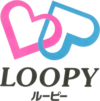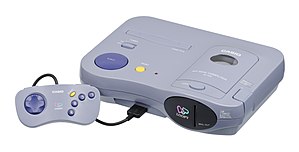
Back Casio Loopy AST Casio Loopy Catalan Casio Loopy German Casio Loopy Spanish Casio Loopy Finnish Casio Loopy French Casio Loopy Italian ルーピー Japanese Casio Loopy Georgian 카시오 루피 Korean
This article needs additional citations for verification. (December 2018) |
 | |
 | |
| Also known as | My Seal Computer SV-100 |
|---|---|
| Manufacturer | Casio |
| Type | Home video game console |
| Generation | Fifth |
| Lifespan |
|
| Introductory price | 25,000¥ |
| Media | ROM cartridge |
| CPU | SH7021 32-bit SuperH |
| Memory | 1MB RAM |
| Storage | 2MB ROM |
| Display | NTSC-M composite video out |
| Graphics | 512 colors |
| Sound | 4 channels, 12-bit PCM |
| Controller input | D-pad and mouse |
| Predecessor | PV-1000 |


The Casio Loopy (Japanese: ルーピー, Hepburn: Rūpī), subtitled My Seal Computer SV-100, is a 32-bit home video game console. Released exclusively in Japan in October 1995 with a price of 25,000¥, the marketing for it was completely targeted to female gamers.[1][2][3]
The console is powered by a Hitachi SH7021 SuperH 32-bit RISC CPU running at 16MHz, and had 1MB of RAM and 2MB of ROM.[4][5] It was capable of displaying 512-color graphics and of playing 4 channels of 12-bit PCM audio.[5]
The Loopy has one controller port[1] for use with a standard game controller or with a mouse which was sold separately.
The Loopy includes a built-in thermal color printer that could be used to create stickers from game screenshots. An optional accessory, called Magical Shop (マジカルショップ, Majikaru Shoppu),[5] was a video capture device to obtain images from VCRs and DVD players. Users may add text to these images and make stickers. Including Magical Shop's own built-in software, the Loopy library contained 11 titles.[5]
Developer Kenji Terada worked on I Want a Room in Loopy Town! (ルーピータウンのおへやがほしい!, Rūpī Taun no O-heya ga Hoshii!).[6]
Software development ended in November 1996, and Casio ceased production of the console in December 1998.[1]
- ^ a b c Packwood, Lewis (2018-07-15). "In the Loopy: the story of Casio's crazy 90s console". Eurogamer.net. Retrieved 2023-03-26.
- ^ Branagan, Nicole (Dec 15, 2021). "Isn't she just Misunderstood? The Casio Loopy!". nicole.express. Retrieved 2023-03-26.
- ^ "Casio Loopy カシオルーピー". FEMICOM. Retrieved 2023-03-26.
- ^ "Casio Loopy". OLD-COMPUTERS.COM : The Museum. Retrieved 20 January 2021.
- ^ a b c d Blanchard, Jonn (29 December 2017). "Casio Loopy". Re-enthused: world of retro. Retrieved 20 January 2021.
- ^ Weil, Rachel (December 4, 2013). "FEMICOM Kenji Terada, writer for early Final Fantasy games, worked on a little-known Animal Crossing-like game in the 1990". FEMICOM Museum. Retrieved 20 January 2021.